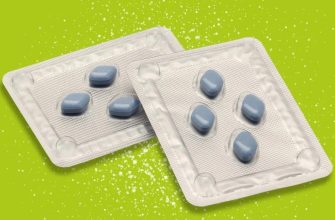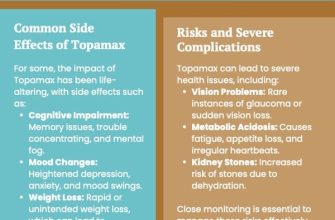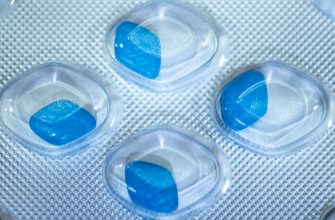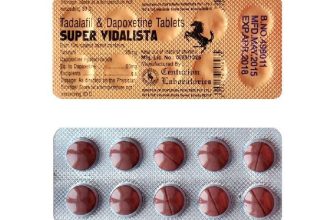Begin with a low dose, typically 10-40mg twice daily, and adjust based on your individual response and physician’s recommendations. This starting point allows for gradual titration, minimizing potential side effects.
Dosage adjustments are crucial. Your doctor will monitor your blood pressure and heart rate, guiding increases or decreases as needed. Regular checkups are vital for optimal management.
Specific conditions influence dosage. For performance anxiety, a lower dose might suffice; for hypertension, a higher dosage, potentially exceeding 160mg per day, might be necessary. Always follow your doctor’s instructions.
Important note: Never alter your dosage without consulting your healthcare provider. Incorrect adjustments can lead to adverse reactions. Open communication with your doctor ensures safe and effective treatment.
Consider these factors: Age, weight, other medications, and underlying health issues influence how your body responds to Propranolol. Honest and detailed communication with your physician is key.
- Propranolol Dosage: A Detailed Guide
- Standard Propranolol Dosage for Hypertension
- Propranolol Dosage for Migraines and Tremors
- Migraine Dosage Considerations
- Propranolol for Tremors
- Important Note
- Adjusting Propranolol Dosage Based on Patient Factors
- Age and Renal Function
- Hepatic Function
- Cardiac Conditions
- Other Medications
- Individual Response
- Important Note:
- Common Side Effects and Dosage Modifications
- Adjusting Your Dose
- Specific Considerations
- Propranolol Dosage in Children and Special Populations
- Important Considerations Before Taking Propranolol
Propranolol Dosage: A Detailed Guide
Your doctor will determine the appropriate Propranolol dosage based on your specific condition and response to treatment. Typical starting dosages vary significantly depending on the indication. For hypertension, a common starting dose is 10-40 mg twice daily. This can be gradually increased as needed, under your doctor’s supervision, to a maximum of 640mg per day, usually divided into several doses.
For angina, initial doses usually range from 10 to 20 mg three or four times a day. Again, adjustments are made based on individual patient response, with close monitoring by your physician.
Migraine prevention often starts with lower doses, such as 40 mg daily, increasing gradually as tolerated. Remember, your doctor will carefully tailor the dosage to your needs and monitor for side effects.
Dosage for performance anxiety or tremor might begin at 10-20 mg twice daily and adjust upwards depending on symptom control. Always consult with a healthcare professional before changing your dosage.
Children’s dosages are calculated according to weight and the specific condition being treated. Precise guidelines are set by pediatric specialists. Always follow your child’s physician’s instructions carefully.
Several factors influence dosage adjustments, including age, liver and kidney function, concurrent medications, and individual patient response. Regular check-ups with your physician are vital for effective management and to detect and manage potential side effects.
Never alter your Propranolol dosage without explicit direction from your doctor. Sudden cessation can lead to adverse effects. Always communicate any concerns or side effects you experience to your healthcare provider.
Standard Propranolol Dosage for Hypertension
Treatment typically begins with a low dose, gradually increasing as needed. A common starting dose is 10 mg twice daily.
Your doctor will monitor your blood pressure and adjust your dosage accordingly. Increases are usually made in increments of 10-20 mg per day, aiming for optimal blood pressure control with the lowest effective dose.
- Typical Dosage Range: 20-80 mg per day, divided into two or three doses.
- Maximum Dosage: Generally, 320 mg daily, though this is rare and only under close medical supervision.
Remember, individual responses to Propranolol vary significantly. Factors like age, weight, and overall health influence dosage requirements.
- Elderly Patients: Often start with lower doses (e.g., 10 mg once or twice daily) due to increased sensitivity.
- Patients with Liver or Kidney Disease: Dosage adjustments are necessary to avoid accumulation of the drug and side effects. Your doctor will carefully tailor your treatment plan.
Always follow your doctor’s instructions precisely and report any side effects immediately. Regular blood pressure monitoring is crucial to ensure safe and effective treatment. Never adjust your dosage without consulting your physician.
Propranolol Dosage for Migraines and Tremors
For migraine prophylaxis, doctors typically prescribe propranolol starting at 10-40mg per day, gradually increasing the dose as needed and tolerated. The maximum daily dose often doesn’t exceed 160mg, divided into two or three administrations. Response varies greatly between individuals; some experience migraine relief at lower doses. Close monitoring by your physician is crucial to find the optimal, effective dosage for you.
Migraine Dosage Considerations
Factors influencing dosage include the severity and frequency of migraines, your age, weight, and other health conditions. Always follow your doctor’s instructions precisely. They will adjust your dosage based on your response and potential side effects. Common side effects, such as fatigue or dizziness, may subside as your body adjusts to the medication.
Propranolol for Tremors
For essential tremors, the starting dose is usually lower, often beginning at 10-20mg twice daily. This dosage can be gradually increased, under medical supervision, to a maximum of 120-240mg daily. Again, individual response varies significantly. The goal is to find the lowest dose that effectively controls your tremors while minimizing potential side effects.
Important Note
This information is for general knowledge only and does not constitute medical advice. Always consult your doctor or a qualified healthcare professional before starting or changing any medication, including propranolol. They will assess your individual needs and determine the appropriate dosage and treatment plan.
Adjusting Propranolol Dosage Based on Patient Factors
Dosage adjustments depend heavily on individual patient characteristics. Begin with a low dose and carefully monitor the response.
Age and Renal Function
- Elderly patients (≥65 years): Often require lower starting doses due to decreased hepatic and renal clearance. Consider a starting dose of 10-20 mg twice daily and titrate slowly.
- Patients with impaired renal function: Dosage reduction may be necessary. Consult renal dosing guidelines, which will often recommend dose reductions depending on creatinine clearance. Closely monitor for side effects.
Hepatic Function
Patients with liver disease may require lower doses due to reduced drug metabolism. Careful monitoring and potentially lower starting dosages are crucial. Consult hepatic dosing guidelines.
Cardiac Conditions
- Bradycardia: Start with a very low dose and monitor heart rate closely. Propranolol can exacerbate bradycardia. Adjust accordingly or consider alternative medications.
- Heart failure: Use with caution and close monitoring. Propranolol can worsen heart failure in some patients. Consider other treatment options.
- Asthma/COPD: Propranolol can worsen bronchospasm in susceptible patients. Use with caution or consider alternative beta-blockers.
Other Medications
Many drugs interact with propranolol. Concurrent use of calcium channel blockers, verapamil or diltiazem, may significantly increase the risk of bradycardia and hypotension. Careful monitoring is needed, and dose adjustments may be required.
Individual Response
- Blood pressure: Monitor blood pressure regularly. Adjust dosage based on response. Target blood pressure goals vary based on individual patient needs.
- Heart rate: Keep track of heart rate. Adjust dose to avoid bradycardia. Maintain a heart rate within a safe therapeutic range.
- Side effects: Observe for side effects like dizziness, fatigue, nausea, or cold extremities. Reduce the dose if side effects are bothersome.
Important Note:
This information is for educational purposes only and does not constitute medical advice. Always consult a healthcare professional before starting or changing any medication, including propranolol. They will tailor the dosage to your specific needs and monitor your progress.
Common Side Effects and Dosage Modifications
Propranolol commonly causes mild side effects like dizziness, fatigue, nausea, and slowed heart rate. These usually lessen as your body adjusts. However, more serious side effects, though rare, include bronchospasm in asthma or COPD patients, and worsening of heart conditions like bradycardia or heart block. Report any concerning symptoms immediately to your doctor.
Adjusting Your Dose
Your doctor will determine your initial dosage based on your specific condition and health. Typical starting doses range from 10mg to 40mg daily, potentially increasing gradually up to a maximum of 320mg daily, divided into multiple doses. Dosage adjustments are common and may be needed due to side effects or insufficient response. For example, if you experience significant dizziness, your doctor may lower the dose or spread it throughout the day. If your condition isn’t responding adequately, they may cautiously increase the dosage. Regular check-ups allow for accurate monitoring and timely adjustments. Never change your dosage without consulting your physician. This is crucial for your safety and treatment efficacy. Remember, individual responses to medication vary considerably.
Specific Considerations
Certain conditions require careful consideration. Patients with liver or kidney problems may need lower doses. Older adults, too, may experience increased sensitivity to side effects and require a more gradual dose escalation. Always inform your doctor about any other medications you’re taking, as interactions can occur. Open communication is key to safe and successful Propranolol treatment.
Propranolol Dosage in Children and Special Populations
Propranolol dosage for children significantly differs from adult dosages and requires careful adjustment based on weight and specific condition. Always follow your doctor’s instructions precisely. Typical starting doses are much lower than those for adults, often in the range of 0.5 to 2 mg/kg/day, divided into two to three doses. This dosage may need gradual increases as tolerated, monitored closely for side effects.
For infants and neonates, dosing is even more cautious and often individualized based on clinical response and close monitoring. Precise dosage guidelines are unavailable; they depend heavily on the infant’s weight and health status, with experienced pediatric cardiologists guiding treatment.
In patients with hepatic or renal impairment, dosage reduction is necessary due to altered drug metabolism and excretion. Your doctor will carefully assess your kidney and liver function before determining the appropriate dose. Lower dosages and longer intervals between doses might be required.
Geriatric patients often have decreased hepatic and renal function, necessitating dosage adjustments similar to those for patients with impaired liver or kidney function. Start with a low dose and monitor closely for any adverse effects. Close collaboration between the patient, their caregiver, and the prescribing physician is crucial in such cases.
Specific conditions will dictate dosage. For example, migraine prophylaxis in children might use a different dosage than treatment for anxiety in adults. The attending physician considers numerous factors, including the patient’s age, weight, overall health, and the specific condition being treated when making decisions on dosage.
| Population | Dosage Considerations |
|---|---|
| Children | Lower initial doses (0.5-2 mg/kg/day), divided doses, careful monitoring for side effects |
| Infants/Neonates | Highly individualized, based on weight and clinical response, under close pediatric supervision |
| Hepatic Impairment | Dosage reduction required due to impaired metabolism |
| Renal Impairment | Dosage reduction required due to impaired excretion |
| Geriatric Patients | Start with a low dose; close monitoring for adverse events |
Remember, this information is for educational purposes only and should not be considered medical advice. Always consult your doctor or a qualified healthcare professional for accurate and personalized recommendations regarding propranolol dosage.
Important Considerations Before Taking Propranolol
Always inform your doctor about all medications you’re currently taking, including over-the-counter drugs, herbal supplements, and vitamins. Propranolol can interact with numerous substances, potentially altering their effects or causing adverse reactions.
Discuss your complete medical history with your physician. Conditions like asthma, bradycardia, heart block, or severe peripheral vascular disease might necessitate adjustments to your propranolol regimen or preclude its use entirely. Pregnancy and breastfeeding also require careful evaluation before starting treatment.
Be aware of potential side effects, such as dizziness, fatigue, and nausea. These are relatively common. Report any concerning symptoms to your doctor immediately. Sudden cessation of propranolol can lead to withdrawal effects, so always follow your doctor’s instructions on tapering the dosage.
Monitor your blood pressure and pulse regularly, especially during the initial phases of treatment. Keep a record of these readings and share them with your doctor during check-ups. This helps assess the medication’s efficacy and identify potential problems early.
Understand that individual responses to propranolol vary significantly. What works well for one person may not be suitable for another. Open communication with your physician is key to optimizing your treatment plan and managing any side effects.
Avoid alcohol consumption while taking propranolol, as this can exacerbate its side effects and lead to hypotension. Be cautious when engaging in activities requiring alertness, like driving or operating machinery, especially during the initial stages of treatment.








